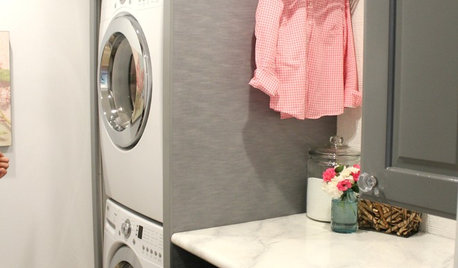Windows Leaking - Now Pulling Off Rock
beachgirlok
16 years ago
Related Stories

GREEN BUILDINGOff the Grid: Ready to Pull the Plug on City Power?
What to consider if you want to stop relying on public utilities — or just have a more energy-efficient home
Full Story
DECORATING GUIDESHow to Pull Off a Minimalist Look Without Sacrificing Your Style
Minimalism doesn’t always mean white and characterless — it’s about playing favorites
Full Story
FURNITURERock Your Socks Off
The Best Rocking Chairs Soothe, Entertain and Serve as Sculpture, Too
Full Story
BEDROOMSHow to Pull Off Mismatched Nightstands
Despite their differences, night tables with unequal heights, varying colors and even odd-couple styles can get along just fine
Full Story
EXTERIOR COLORDynamic Duo: How to Pull Off a Two-Tone Exterior Color Scheme
Why stick to one main house color if you can easily and beautifully combine two?
Full Story
LAUNDRY ROOMSHouzz TV: Mother of 6 Rocks Her Laundry Space
You may have read the story — now see in action the clever DIY solutions that make this laundry room an organizational heaven
Full Story
WINDOWSSalvage Spotlight: Warehouse Windows Become a Storage Screen
Full of character but originally short on practicality, these panes in a Brooklyn loft now hide gear instead of leaking air
Full Story
REMODELING GUIDESOriginal Home Details: What to Keep, What to Cast Off
Renovate an older home without regrets with this insight on the details worth preserving
Full Story
GREEN BUILDINGHouzz Tour: Going Completely Off the Grid in Nova Scotia
Powered by sunshine and built with salvaged materials, this Canadian home is an experiment for green building practices
Full Story
DECORATING GUIDES10 Inspired Ways to Refresh Your Mantel Now
Postholiday blahs don't stand a chance on your mantel when you incorporate these ways to accessorize and light it
Full StoryMore Discussions










lyfia
gardenchick1
Related Professionals
Central Islip Architects & Building Designers · Mililani Town Design-Build Firms · Shady Hills Design-Build Firms · Westmont Home Builders · Alabaster General Contractors · Chillicothe General Contractors · Citrus Heights General Contractors · Claremont General Contractors · Country Club Hills General Contractors · Geneva General Contractors · Highland City General Contractors · Montebello General Contractors · Palestine General Contractors · Rohnert Park General Contractors · Troutdale General Contractorssierraeast
dixiedoodle
sierraeast
worthy
beachgirlokOriginal Author
sierraeast
demerara
sierraeast
beachgirlokOriginal Author
rollie
worthy
beachgirlokOriginal Author
worthy
beachgirlokOriginal Author
sierraeast
worthy
beachgirlokOriginal Author
worthy
beachgirlokOriginal Author
worthy
allison0704